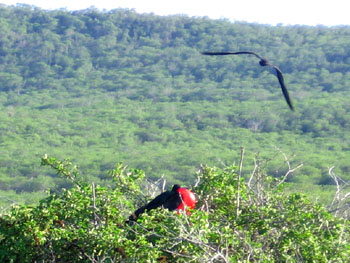 The Birds The Birds
The
magnificent frigate birds and the great frigate birds inhabit these
islands and follow boats for hours with hardly any flapping of their
wings. We learned that they don't dive for fish like other sea
birds, but steal from those that do. So they float high
above the water and watch for a booby (We'll get to those next.)
that has caught a fish. When that happens, they chase it, bite
its tail so it squawks, and then dip under the bird to catch the
falling fish. It seems too complex, but we did see this
happen.
<< Anyway,
here is a male frigate with his inflated red throat working to
attract a female. We were about 20 yards away.
We saw two two kinds of boobies: the blue-footed
boobies and the Nazca boobies. These birds make long vertical
dives into the water to fish--it was fun to watch them fish, but
more thrilling to walk right up to them in their nesting
areas. They were unconcerned about us.
|